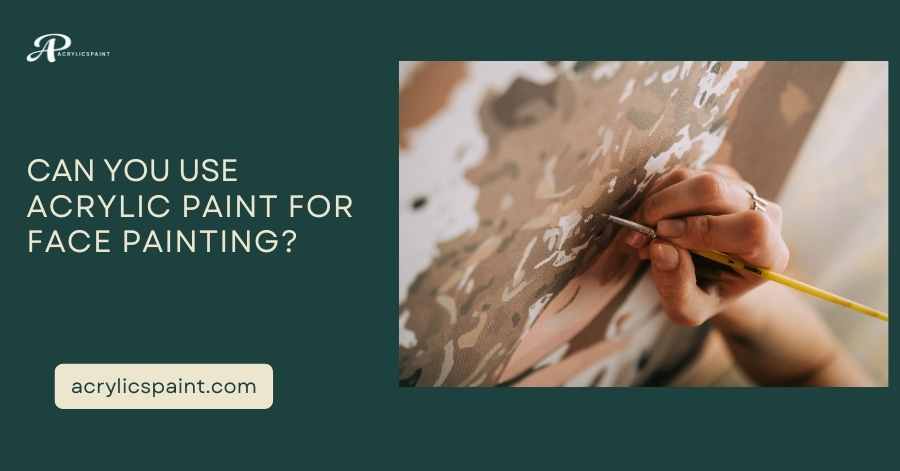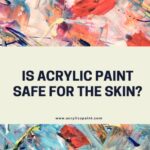Can you use acrylic paint for face painting? – Face painting is a fun and creative activity for people of all ages. It’s a great way to add flair to a party, festival, or other special event. But when it comes to choosing the right paint for the job, safety is paramount. In this blog post, we’ll explore whether acrylic paint can be used for painting and discuss some safe and effective alternatives.
What is Acrylic Paint?
Acrylic paint is a popular medium used in various art projects. It consists of pigment suspended in an acrylic polymer emulsion, resulting in quick-drying and water-resistant paint. Artists commonly use acrylics on canvas, wood, paper, and other surfaces due to their vibrant colours and durability.
Can You Use Acrylic Paint for Face Painting?
While acrylic paint offers vivid hues and long-lasting results, it is not recommended for face painting. Unlike paints specifically formulated for use on the skin, acrylics contain chemicals and pigments that may be harmful when applied to delicate facial skin.
Is Acrylic Paint Safe for Your Face?
No, acrylic paint is not safe for your face. Acrylics contain ingredients that can cause skin irritation, allergic reactions, and other adverse effects when applied directly. These paints are formulated for use on surfaces other than the human body and may contain toxic substances unsuitable for skin contact.
Why Acrylic Paint is Not Recommended for Face Skin
While acrylic paint is a versatile and affordable art medium, it’s unsuitable for face painting. Here’s why:
Toxicity
Acrylic paints contain pigments and chemicals that can be toxic if ingested or absorbed through the skin. This is especially risky for children, who are likelier to put their fingers in their mouths.
Cracking
Acrylic paint dries hard and can crack as the face moves. These cracks can trap dirt and bacteria, leading to skin irritation or infection.
Difficulty Breathing
Inhaled acrylic paint fumes can irritate the lungs and cause difficulty breathing.
Are All-Purpose Can you use acrylic paint for face painting?
No, all-purpose acrylic paints are not safe for face painting. While they may be labeled as non-toxic, these paints are not intended for use on the skin and may still contain ingredients that can cause harm. Choosing paints specifically designed and labeled for use on the face and body is essential.
What Paints Are Safe for Skin?
Using paints specifically formulated for the skin is crucial for safe and enjoyable face-painting experiences. Look for water-based paints that are labeled as non-toxic and hypoallergenic. These paints are gentle on the skin, making them suitable for children and individuals with sensitive skin.
Safe Alternatives to Acrylic Paint for Face Painting
There are many safe and effective alternatives to acrylic paint for face painting. Here are a few of the most popular options:
Water-based face paints
These paints are safe for use on the skin and typically contain ingredients like glycerin, vegetable gums, and FDA-approved pigments. They are gentle on the skin, easy to apply and remove, and come in various vibrant colors.
Glycerin-based face paints
Glycerin-based face paints offer a gentle and hydrating formula that is less likely to cause skin irritation. These paints provide vibrant colors and are often used by professional face painters for their long-lasting and smudge-resistant properties.
Oil-Based Face Paints
Oil-based face paints provide rich colors and excellent coverage, but they may only be suitable for some skin types. Individuals with sensitive skin should exercise caution when using oil-based paints and perform a patch test before applying them to larger face areas.
Paraffin wax-based face paints
Professional face painters often use these paints because they are durable and long-lasting. However, they can be more challenging to remove than water-based paints.
Choosing the Right Face Paint

When choosing paint, look for products that are:
- Non-toxic: Make sure the face paint is labeled as non-toxic and ASTM D-4236 compliant. This means the paint is safe to use on the skin.
- Hypoallergenic: If you have sensitive skin, look for hypoallergenic face paint that is less likely to irritate.
- Fragrance-free: Fragrances can irritate the skin, so choosing fragrance-free paint is best.
- Age-appropriate: Some face paints are not recommended for young children. Read the label carefully before using paint on a child.
- Read Labels Carefully: Always check the ingredients list and look for hypoallergenic and non-toxic formulations.
- Patch Test: Before applying face paint, especially on children, do a patch test on a small arm area to check for reactions.
Best Face Paint Brands
The world of face painting boasts many brands that offer high-quality, safe products. Here are some popular choices:
- Snazaroo
A well-known brand offering water-based face paints perfect for beginners and professionals alike.
- Mehron
A professional-grade brand with a vast selection of paints in various types and colors.
- Face Paints by Global
A cruelty-free brand that offers hypoallergenic and vibrant paints.
Tips for Safe Painting
Here are some additional tips for safe face painting:
- Always do a patch test before applying face paint to the face. Apply a small amount of paint to the inner arm and wait 24 hours for any reaction.
- Wash the area with soap and water before applying face paint.
- Apply the paint in thin layers.
- Avoid applying paint around the eyes and lips.
- Do not let children put their fingers in their mouths while wearing paint.
- Remove paint with soap and water or a gentle makeup remover.
Conclusion
While acrylic paint may be suitable for various art projects, there are better options for face painting due to safety concerns. When painting on the face, it’s essential to prioritize the health and well-being of the skin. Choose paints specifically formulated for use on the face and body, and follow best practices to ensure a safe and enjoyable experience for everyone involved. Happy painting!
In summary, Can you use acrylic paint for face painting? acrylic paint is not safe for face painting, and it’s best to opt for water-based face paints that are non-toxic and hypoallergenic. Choosing suitable paints and following proper techniques can create beautiful, memorable face-painting designs without compromising safety.












